 He lived only for revenge…She lived only for his love!
He lived only for revenge…She lived only for his love!
By the middle of the 1940s it was becoming clear that in John Wayne Republic Pictures had a leading star on their hands. As the 40s progressed you can see the quality of Wayne’s pictures with Republic growing almost exponentially, climaxing with 1949’s Sands of Iwo Jima, which garnered the star his first Academy Award nomination.
Knowing that they couldn’t keep Wayne under contract solely with money (as Republic was cash-poor when compared to many studios), they placated in other ways. In addition to better scripts, they also got better supporting casts and allowed Wayne to create his own production company. In 1947 they even let him produce his first picture, Angel and the Badman.
Angel and the Badman is in some ways an odd choice for John Wayne’s first production, though in others it shows a bit of a precursor of how he handled his later career. For the film isn’t an action packed feature with Wayne in a forceful leading role. For though the action scenes are good- if rather formulaic and staid- the focus of the picture seems to be on both Wayne’s character’s turn to religion and his budding relationship with his leading lady, both on and off screen.
Wayne is Quirt Evans, a once honorable man who has become a bit disillusioned and turned to robbery, rustling and general mayhem. As the film starts he’s injured from his latest escapade and on the verge of unconsciousness. The Worth family takes him in and nurses him back to health.
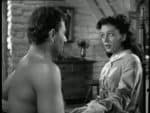 His main caretaker is the family’s daughter, Penelope, played by Gail Russell. Penelope nurses him back to health and exposes Quirt to her Quaker faith, surprising him with her wholesome goodness. As he recovers we can see him his disposition turn a bit as he realizes that there are still good people in the world.
His main caretaker is the family’s daughter, Penelope, played by Gail Russell. Penelope nurses him back to health and exposes Quirt to her Quaker faith, surprising him with her wholesome goodness. As he recovers we can see him his disposition turn a bit as he realizes that there are still good people in the world.
He begins to leave his gun outside and adopt non-violent methods in respect of the family’s values. At first he’s surely just humoring them or perhaps just working for cache with Penelope, but as things progress he’s clearly incorporating those values for their own worth.
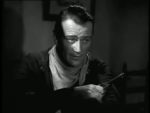 He heads next door and convinces their neighbor, who has dammed up their water supply, to share his water with those living downstream. Surely earlier Quirt would have simply blasted him or simply not cared at all, but now he lets his reputation and a simple request do his talking for him.
He heads next door and convinces their neighbor, who has dammed up their water supply, to share his water with those living downstream. Surely earlier Quirt would have simply blasted him or simply not cared at all, but now he lets his reputation and a simple request do his talking for him.
After being chased into a river with Penelope by his long-time nemesis Laredo Stevens (Bruce Cabot) he momentarily turns back to the ‘dark side’ and has a night of debauchery, meeting up with an old partner in crime with some female acquaintances in a saloon. After the resulting brawl, Quirt realizes that his old lifestyle no long suits him and he heads back to the Worth farm.
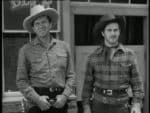 The final showdown with Laredo and town is a bit anticlimactic but not entirely unexpected. Though I won’t give it away it is a bit of a non-event, though it is a great scene for the local Marshal (Harry Carey). Carey pops in a few times throughout the film with a whimsical mix of lines which are partly humorous and partly prophetic.
The final showdown with Laredo and town is a bit anticlimactic but not entirely unexpected. Though I won’t give it away it is a bit of a non-event, though it is a great scene for the local Marshal (Harry Carey). Carey pops in a few times throughout the film with a whimsical mix of lines which are partly humorous and partly prophetic.
Director James Edward Grant does a functional if unexceptional job. As mentioned earlier the focus here isn’t really on the action sequences and though they are fine they also resemble a bit of a paint by numbers kit as well, with the exception of a few surprisingly poor rear projection sequences.
Bruce Cabot traipses through a few scenes without much to do except play a cardboard foil for Wayne. Though a history for their rivalry would have been interesting, we just enough to move the story ahead. Harry Carey’s role, though equally small, is very enjoyable with his quirky banter. Seemingly only some smaller roles got fleshed out.
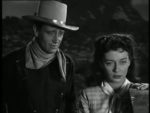 More attention seems to have been paid- and rightly so- to the dynamic between Quirt and Penelope. There are many lingering shots of both characters as they interact. This is more true in regards with Penelope, perhaps in large part to Wayne’s production edits. Though some of the shots make sense (such as when Penelope first sees Wayne shirtless), others seem to last just a bit too long.
More attention seems to have been paid- and rightly so- to the dynamic between Quirt and Penelope. There are many lingering shots of both characters as they interact. This is more true in regards with Penelope, perhaps in large part to Wayne’s production edits. Though some of the shots make sense (such as when Penelope first sees Wayne shirtless), others seem to last just a bit too long.
The backstory of the film is that Wayne was rumored to be in the middle of a torrid affair with Gail Russell during the filming of Angel and the Badman. Though unconfirmed it is clear that Wayne had a soft spot for her, though this could have been caused by his realization of the degree of her dependency on alcohol, which she used at least initially to combat her tremendous stage fright. Ultimately Russell wasn’t able to control her demons and she passed away at the age of 36 due to alcohol related liver failure.
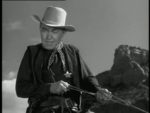 What is clear here is that regardless of the reason there is definitely chemistry on screen between the two leads. In addition to the consistent fixation on Russell’s expressions, we also get quite a few shots of Wayne’s as well.
What is clear here is that regardless of the reason there is definitely chemistry on screen between the two leads. In addition to the consistent fixation on Russell’s expressions, we also get quite a few shots of Wayne’s as well.
Here we see from Wayne in many cases much more acting than he was usually given credit for. We can feel his earnestness in his eyes when he reaches for his gun hanging on a peg, only to soften, glancing down in embarrassment after locking eyes with Russell, whose eyes return simple loving disapproval.
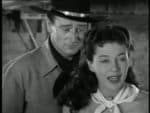 As much as Wayne demonstrates some usually unnoted range he’s also clearly sleepwalking just a bit, letting the plot and emotion carry him along with the others. Clearly there should have been more development of Cabot’s character and more creativity in the action sequences. Stock cattle drives and barroom brawls are clearly beneath The Duke.
As much as Wayne demonstrates some usually unnoted range he’s also clearly sleepwalking just a bit, letting the plot and emotion carry him along with the others. Clearly there should have been more development of Cabot’s character and more creativity in the action sequences. Stock cattle drives and barroom brawls are clearly beneath The Duke.
Angel and the Badman overall is a pretty good picture but lacks real punch which could have made it much better.